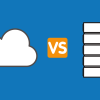Cloud computing has revolutionized how we store, access, and process data, fundamentally changing the way businesses and individuals interact with technology. At its core, cloud computing is the on-demand delivery of computing services—including servers, storage, databases, networking, software, and analytics—over the internet. Rather than owning and maintaining physical hardware, users can access these resources remotely through what we commonly call “the cloud.”
The term “cloud” doesn’t refer to something floating in the sky, but rather to remote servers and powerful mainframe computers housed in large data centers that you access through the internet. This revolutionary approach allows you to get the computing power or storage you need without having to own or manage the physical hardware yourself. Whether you’re checking Gmail, streaming Netflix, or using business applications, you’re likely already using cloud computing in your daily life.
What makes cloud computing so transformative is its fundamental shift from traditional IT infrastructure. Instead of businesses investing heavily in expensive servers, software licenses, and maintenance, they can simply pay for what they use through a utility-based model. This approach offers unprecedented flexibility, allowing organizations to scale their operations up or down based on demand without the burden of managing physical infrastructure.
The cloud computing model operates on five essential characteristics that distinguish it from traditional computing approaches: on-demand self-service, broad network access, resource pooling, rapid elasticity, and measured service. These characteristics work together to create a seamless, efficient, and cost-effective computing environment that has become indispensable for modern businesses and individuals alike.
How Cloud Computing Works
Cloud computing operates through a sophisticated network infrastructure that connects users to remote data centers via the internet. The system consists of two primary layers: the front-end, which includes the user’s device and interface, and the back-end, which comprises the servers, databases, and applications that power cloud services.
High-speed networking connections, typically through wide-area networks (WANs), facilitate communication between front-end users and back-end resources. Advanced technologies like load balancers, content delivery networks (CDNs), and software-defined networking (SDN) ensure data flows quickly and securely between users and cloud resources.
Virtualization plays a crucial role in cloud computing functionality. Cloud providers use special software to abstract and pool IT infrastructure, allowing a single physical server to be divided into multiple virtual servers. This virtualization enables maximum utilization of data center resources and provides the flexibility that makes cloud computing so efficient.
Essential Characteristics of Cloud Computing

Cloud computing is defined by five fundamental characteristics that set it apart from traditional computing models:
On-Demand Self-Service allows users to automatically provision computing resources like server time and network storage without requiring human interaction with service providers. This characteristic gives users complete control and agility to meet their evolving needs.
Broad Network Access ensures cloud services are available over the network through standard devices including mobile phones, tablets, laptops, and workstations. This universal accessibility makes cloud computing truly ubiquitous.
Resource Pooling enables cloud providers to serve multiple consumers using a multi-tenant model, with physical and virtual resources dynamically assigned based on demand. This pooling creates economies of scale that benefit all users.
Rapid Elasticity allows resources to be quickly scaled up or down, often automatically, to match demand fluctuations. To users, available resources often appear unlimited and can be accessed in any quantity at any time.
Measured Service means cloud systems automatically control and optimize resource usage through metering capabilities, providing transparency for both providers and consumers. This measurement enables the pay-as-you-go pricing model that makes cloud computing so cost-effective.
Key Benefits of Cloud Computing
Cloud computing offers numerous advantages that have made it the preferred choice for businesses and individuals worldwide:
Cost Reduction represents one of the most significant benefits. Organizations avoid substantial capital expenditures on infrastructure by using cloud providers’ resources instead of purchasing expensive hardware. The pay-as-you-go model ensures businesses only pay for services they actually use, further reducing costs.
Scalability and Flexibility allow organizations to grow from a few users to thousands quickly, scaling storage and computing needs up or down as required. This flexibility enables businesses to adapt rapidly to changing market conditions and customer demands.
Enhanced Security and Reliability come through centralized data management and advanced security measures including encryption and threat monitoring. Networked backups prevent data loss from hardware failures, while cloud platforms help ensure compliance with industry regulations.
Improved Collaboration and Productivity result from cloud computing’s ability to make data and applications accessible from anywhere with an internet connection. This accessibility has become particularly valuable for enabling remote work and seamless omnichannel customer engagement.




